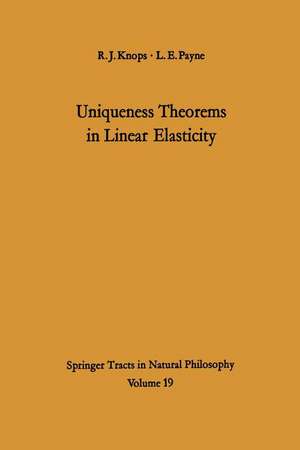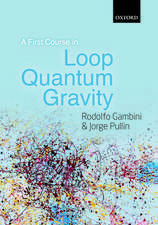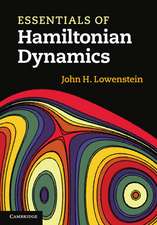Uniqueness Theorems in Linear Elasticity: Springer Tracts in Natural Philosophy, cartea 19
Autor Robin J. Knops, L. E. Payneen Limba Engleză Paperback – 18 noi 2011
Din seria Springer Tracts in Natural Philosophy
-
 Preț: 378.92 lei
Preț: 378.92 lei -
 Preț: 389.88 lei
Preț: 389.88 lei -
 Preț: 376.22 lei
Preț: 376.22 lei -
 Preț: 489.59 lei
Preț: 489.59 lei -
 Preț: 383.33 lei
Preț: 383.33 lei -
 Preț: 386.61 lei
Preț: 386.61 lei -
 Preț: 386.00 lei
Preț: 386.00 lei -
 Preț: 383.33 lei
Preț: 383.33 lei -
 Preț: 378.34 lei
Preț: 378.34 lei -
 Preț: 380.63 lei
Preț: 380.63 lei -
 Preț: 382.57 lei
Preț: 382.57 lei -
 Preț: 377.57 lei
Preț: 377.57 lei -
 Preț: 379.86 lei
Preț: 379.86 lei -
 Preț: 393.74 lei
Preț: 393.74 lei -
 Preț: 376.04 lei
Preț: 376.04 lei -
 Preț: 486.16 lei
Preț: 486.16 lei -
 Preț: 356.38 lei
Preț: 356.38 lei - 20%
 Preț: 562.40 lei
Preț: 562.40 lei -
 Preț: 390.63 lei
Preț: 390.63 lei -
 Preț: 391.61 lei
Preț: 391.61 lei -
 Preț: 453.78 lei
Preț: 453.78 lei -
 Preț: 422.31 lei
Preț: 422.31 lei - 15%
 Preț: 630.43 lei
Preț: 630.43 lei -
 Preț: 383.12 lei
Preț: 383.12 lei - 15%
 Preț: 575.41 lei
Preț: 575.41 lei -
 Preț: 377.57 lei
Preț: 377.57 lei -
 Preț: 382.57 lei
Preț: 382.57 lei -
 Preț: 379.86 lei
Preț: 379.86 lei - 15%
 Preț: 631.21 lei
Preț: 631.21 lei - 15%
 Preț: 634.32 lei
Preț: 634.32 lei - 15%
 Preț: 637.78 lei
Preț: 637.78 lei - 18%
 Preț: 786.84 lei
Preț: 786.84 lei -
 Preț: 391.99 lei
Preț: 391.99 lei -
 Preț: 348.98 lei
Preț: 348.98 lei -
 Preț: 386.22 lei
Preț: 386.22 lei -
 Preț: 379.48 lei
Preț: 379.48 lei -
 Preț: 378.54 lei
Preț: 378.54 lei - 15%
 Preț: 647.59 lei
Preț: 647.59 lei -
 Preț: 378.12 lei
Preț: 378.12 lei
Preț: 379.48 lei
Nou
Puncte Express: 569
Preț estimativ în valută:
72.61€ • 75.81$ • 60.10£
72.61€ • 75.81$ • 60.10£
Carte tipărită la comandă
Livrare economică 04-18 aprilie
Preluare comenzi: 021 569.72.76
Specificații
ISBN-13: 9783642651038
ISBN-10: 3642651038
Pagini: 144
Ilustrații: X, 132 p.
Dimensiuni: 155 x 235 x 8 mm
Greutate: 0.21 kg
Ediția:Softcover reprint of the original 1st ed. 1971
Editura: Springer Berlin, Heidelberg
Colecția Springer
Seria Springer Tracts in Natural Philosophy
Locul publicării:Berlin, Heidelberg, Germany
ISBN-10: 3642651038
Pagini: 144
Ilustrații: X, 132 p.
Dimensiuni: 155 x 235 x 8 mm
Greutate: 0.21 kg
Ediția:Softcover reprint of the original 1st ed. 1971
Editura: Springer Berlin, Heidelberg
Colecția Springer
Seria Springer Tracts in Natural Philosophy
Locul publicării:Berlin, Heidelberg, Germany
Public țintă
ResearchCuprins
1 Introduction.- 2 Basic Equations.- 2.1 Formulation of Initial-Boundary Value Problems.- 2.2 The Classical and Weak Solutions.- 2.3 The Homogeneous Isotropic Body. Plane Elasticity.- 2.4 Definiteness Properties of the Elasticities.- 3 Early Work.- 4 Modern Uniqueness Theorems in Three-Dimensional Elastostatics.- 4.1 The Displacement Boundary Value Problem for Bounded Regions.- 4.2 Exterior Domains.- 4.3 The Traction Boundary Value Problem.- 4.4 Mixed Boundary Value Problems.- 5 Uniqueness Theorems in Homogeneous Isotropic Two-Dimensional Elastostatics.- 5.1 Kirchhoff’s Theorem in Two-Dimensions. The Displacement and Traction Boundary Value Problems.- 5.2 Uniqueness in Plane Problems with Special Geometries.- Appendix: Uniqueness of Three-Dimensional Axisymmetric Solutions.- 6 Problems in the Whole- and Half-Space.- 6.1 Specification of the Various Boundary Value Problems. Continuity onto the Boundary and in the Neighbourhood of Infinity.- 6.2 Uniqueness of Problems (a)-(d). Corollaries for the Space EN.- 6.3 Uniqueness for the Mixed-Mixed Problem of Type (e).- 7 Miscellaneous Boundary Value Problems.- 7.1 Problems for a Sphere.- 7.2 The Cauchy Problem for Isotropic Elastostatics.- 7.3 The Signorini Problem. Other Problems with Ambiguous Conditions.- 8 Uniqueness Theorems in Elastodynamics. Relations with Existence, Stability, and Boundedness of Solutions.- 8.1 The Initial Displacement and Mixed-Boundary Value Problems. Energy Arguments.- 8.2 The Initial-Displacement Boundary Value Problem. Analyticity Arguments.- 8.3 The Initial-Mixed Boundary Value Problem for Bounded Regions. Further Arguments.- 8.4 Summary of Existing Results in the Uniqueness of Elastodynamic Solutions.- 8.5 Non-Standard Problems, including those with Ambiguous Conditions.- 8.6 Stability,Boundedness, Existence and Uniqueness.- References.











